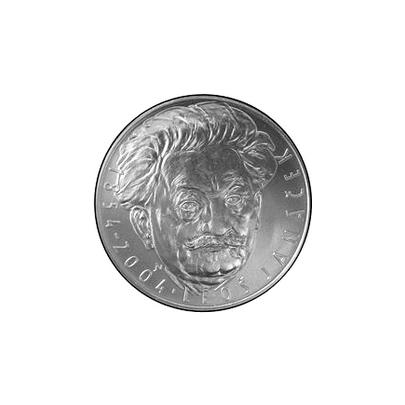Silver Coin 200 CZK Leoš Janáček 150th Anniversary of Birth 2004 Proof
Issue: 23.6.2004
The product cannot be ordered now.
NOT IN STOCK
Detailed description
Leoš Janáček - 150th anniversary of his birth

On the obverse side of the bicentenary there is an unsealed inscription with the name of the state "CZECH REPUBLIC" indicating the nominal value of the coin with the abbreviation of the monetary unit "200 CZK" at the left, bottom and right edge of the coin. At the upper edge of the bicrown is the mint mark. Inside the coin's field is an artistic grouping of heraldic animals from the state emblem on a background of rectangular fields, and below it is Janáček's musical score to the Ukvalá folk poetry in song.
On the reverse, the portrait of Leoš Janáček occupies most of the coin's field. In the unsealed copy at the left, bottom and right edges of the bicrown are the years "1854-2004" and the composer's name. The author of the design of the bicentenary is the academic sculptor Jiří Věneček, whose initials 'jv' are placed next to the portrait at the bottom left.
Leoš Janáček (3 July 1854, Hukvaldy - 12 August 1928, Ostrava) was a world-renowned Czech composer of classical music. He is especially appreciated for his unusual melodicism, based on the folk music of the Moravian regions, especially Slovácko and Laško. He is known worldwide mainly for his operas, the orchestral-vocal work Glagolitic Mass, Sinfonietta, the symphonic poem Taras Bulba and chamber works, especially string quartets.

One of the most original figures of Czech and world musical modernism, he was born in the village of Hukvaldy in north-eastern Moravia on 3 July 1854. He first studied at the monastery school in Brno, where he received a basic musical education. He later graduated from the gymnasium there. He then went to Prague, where he studied at the organ school and received further musical education in Leipzig and Vienna.
Later he returned to Brno, where he took part in national liberation activities. In 1881 he founded an organ school and became its first director. He worked as a conductor and very soon began his career as a composer. After the establishment of Czechoslovakia, he worked together with Vilém Kurz as a professor at the Brno branch of the Prague Conservatory's master school and in 1919 he founded the Brno Conservatory.
Very soon he married his sixteen-year-old pupil Zdeňka Schulzová. A year later they had a daughter, Olga, and later a son, Vladimír, but both died; the son at the age of two and a half, the daughter when she was 21.
At the beginning of his career as a composer, he was inspired by Moravian folk song, using its melodies and studying the rhythm and intonation of speech, which he later translated into his music in an original way. He also studied Russian folk music. He also devoted himself to the folk song of his native Lachian folk culture as a collector and folklorist. Following the model of Dvořák's Slavonic Dances, he composed a similar set, inspired by the folk music of his native region, called Lachian Dances.
Each silver coin is stored in a protective plastic capsule and placed in a dark blue box along with a certificate of authenticity from the CNB.

Product Specifications
Application form
Thanks to our position on the market, we can try to provide you with a product that is currently sold out or unavailable for a longer period of time. Simply fill in the application form and we will contact you as soon as we are able to secure the product.
Filling in the application form is not binding for you.
Buyback contact form
We will be happy to buy investment metals purchased from us or from our competitors. Our customers always get the highest price offered at any given time. Fill out the form below and we will contact you. Thank you for your trust.







